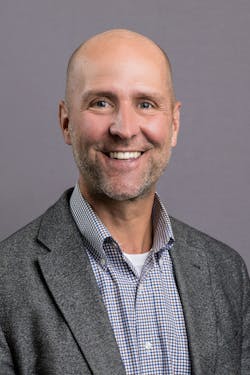It has always been true—to survive, a business must adapt. Adapting is no small feat. Only 52 U.S. companies remained on the Fortune 500 list from 1955 until 2019.
And, one could argue that manufacturing is facing one of its largest disruptions—digital transformation—in modern history.
“My prediction is that half of all American manufacturers will close their doors in the next 10-to-15 years,” says Jeremy Frank, CEO of KCF Technologies. Frank says he has heard loud and clear what’s going on with the sector as a member of National Association of Manufacturers, a board member of the Hydraulic Institute, an active participate in a local MEP and by working with manufacturers including the world’s largest automotive companies.
Of course, he doesn’t want to see that happen, so he formed his business in 2000 with the vision of “solving problems through the convergence of technology and people.” It’s the combination of these two essential components that will “save” manufacturing, he says. It’s very personal to Frank. At a recent company event he recalled, with emotion, how the factory where his grandfather worked, Westinghouse in Mansfield, Ohio, shut down and is now an empty parking lot.
Avoiding that fate is his life’s mission. While his company advises manufacturers on what technologies will make them more efficient and able to stay in business, he’s calling for a public policy that ensures the vibrancy of the sector. He points to one plan that isn’t hitting the mark. The American Jobs Plan Initiative aims to creates job, but not the right ones. Frank says, “Simply creating more jobs is short-sighted and does nothing to address the manufacturing skills gap—specifically, the need for workers who can manage Industry 4.0 technology.”
However, there are some government-backed plans that work very well. Frank points to the model of the Small Business Innovation Research program (SBIR), which invests in entrepreneurial companies. Each year the government sets aside around $3 billion for external R&D to small businesses. This program, along with the Small Business Technology Transfer program, which the SBA calls America’s Seed Fund, allows small businesses to explore technology with the goal of commercialization.
“It’s a competitive process and has proven to be successful,” Frank says, noting that his company received $1 million in 2004 and today is a growing, thriving company. He thinks this program should be expanded. “We should be putting 10 times that number into small businesses as they create the majority of the jobs. And these are the companies tapping into the technology which will solve the knowledge gaps as well as create technologies of the future.”
We also need to rework our education systems, says Frank. “It’s very hard for a two-year community college to be able to change quickly enough to match the expanding technological skills needed.”
That’s why more employers are creating internal programs for on-the-job training.
NAM agrees and in September of 2021, called for Congress to update workforce development programs. Leah Curry, president of Toyota Motor Manufacturing Indiana, and member of NAM’s Manufacturing Institute, testified to the Senate Subcommittee on Employment and Workforce Safety, urging Congress to consider workforce development policies in combination with education policies.
“If education policies are not flexible enough to allow students to explore various pathways,” Curry says, “students may ultimately bypass even the best workforce development opportunities. I came across the idea of pursuing technology as a career by chance after already embarking on a serious course of post-secondary studies. If I was exposed to technical or STEM programs before college, I would have landed on my pathway much sooner.”
Attracting talent early and positioning the field in the light of entrepreneurship is Frank’s prescription for ensuring the health of the manufacturing sector. “We need to get people excited about technology and about building something for the future.”





